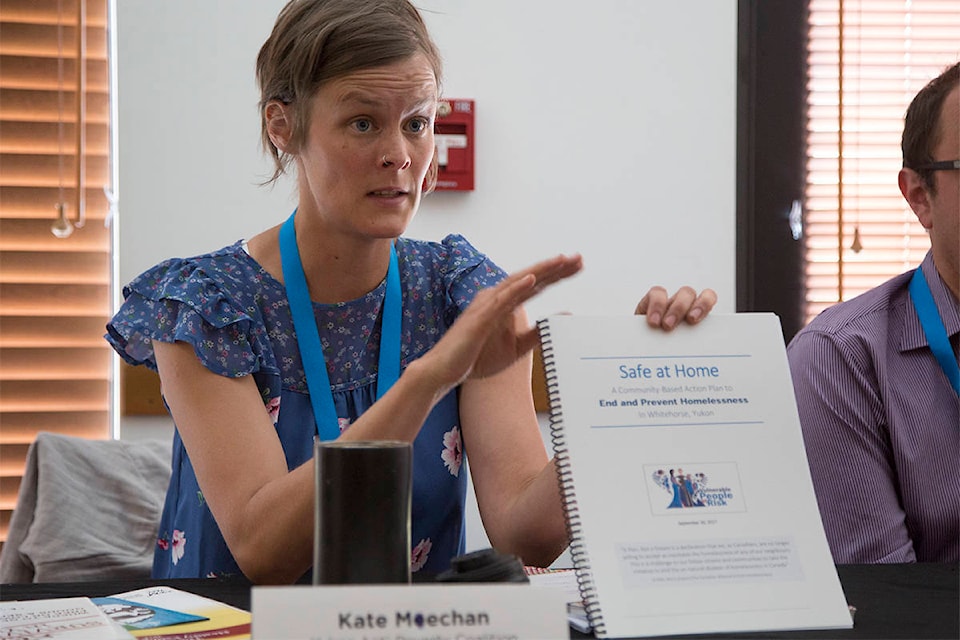A 28-page document released Aug. 21 and detailing three years of work under the Safe at Home plan — which aims to prevent and end homelessness in Whitehorse — shows at least 112 people who were experiencing homelessness in 2018-19 have been housed through the work of five organizations.
The Safe at Home Progress Report details how many were able to find housing as well as the number of housing units that have become available through initiatives like development incentives and grant programs, as well as programs and initiatives set up to help prevent homelessness.
While the number of those who gained housing may not seem like a lot, it has a big impact, says Safe at Home implementation manager Kate Mechan, pointing out that those numbers represent individuals.
“It’s taken a lot of hard work,” she said, noting it is the work of several government and organizations involved in Safe at Home that has moved efforts closer to the goals set out in the plan.
“There is no single effort that will end and prevent homelessness and there is no one government, organization, or person responsible to implement all the solutions,” Mechan said in highlighting the many initiatives that have been taken on by numerous governments and organizations.
The report shows, for example, 463 new housing units built in the past three years through the City of Whitehorse’s development incentives aimed at increasing the number of rentals and supportive housing available in the city. Nearly 400 were built with the help of territorial funding programs.
The report also highlights a number of supportive housing projects like Blood Ties Four Direction’s Steve Cardiff Tiny Home Community, which saw five tiny homes built to provide supported housing to people with addictions, complex health challenges and who may have previously experienced homelessness.
There’s also Options for Independence’s Aurora group home, which provides housing to three women with fetal alcohol spectrum disorder in addition to the 14 supportive housing units that were already in place at the Fourth Avenue location; and the three units at Max’s Place which provides housing to three men with FASD.
Affordable housing is also highlighted in the River Bend development in Whistle Bend. Phase 1 of the project was finished in 2018 with construction of Phase 2 underway. The project is being developed as a partnership between the Ta’an Kwäch’än Council (TKC), Da Daghay Development Corp., Yukon Housing, City of Whitehorse and the Canada Housing and Mortgage Corporation. The 42 units built in Phase 1 are currently housing 60 TKC citizens.
“TKC’s commitment to ensuring all citizens have access to affordable housing continues to be our top priority,” TKC Chief Kristina Kane said in a statement. “Our government’s partnership in the River Bend Project is just one example of what can work to alleviate the housing crisis we are seeing here in Whitehorse. It is initiatives like this that bring positive change to our community. Having affordable housing is more than having a roof, it’s the overall security that leads to better life choices, better health and much needed stability for our children. By sharing our progress and working together with other agencies and governments we are moving in the right direction.”
Acting Kwanlin Dün First Nation Chief Jessie Dawson also praised the Safe at Home plan as a “collaborative holistic approach, embracing unique circumstances; includes the voice of lived experiences; with aims to meet the needs of our community’s most vulnerable.”
Pauline Frost, minister of health and social services as well as the minister responsible for Yukon Housing, said she’s pleased to see the progress that has come from Safe at Home, but also noted there is more work to do.
“Cooperation between governments in collaboration with community organizations is integral to addressing homelessness and housing insecurity in Yukon,” she said.
The report highlights a number of areas where efforts could be strengthened, ranging from launching the Safe at Home website (expected in September) to working towards monitoring and enforcing minimum rental standards.
Whitehorse Mayor Dan Curtis stressed the city’s commitment to continue its efforts “so the plan can be as effective as possible”.
In the immediate future, Mechan said work will continue in launching the new Safe at Home website and pulling many of the various efforts in homelessness under one Safe at Home organization.
There’s also a new housing stability worker position at the Whitehorse Emergency Shelter, whose focus will be on assisting long-term shelter clients in finding more permanent housing.
“That work’s going to continue,” Mechan said of the many initiatives to help ensure housing is available, also highlighting efforts to develop stronger relationships in other Yukon communities, working with First Nations to identify where supports may be needed and working to provide those supports.
She also she would like to see any future progress reports done in a shorter time frame, noting she would ultimately like to see an annual report done and made available on the new website.
Contact Stephanie Waddell at stephanie.waddell@yukon-news.com
